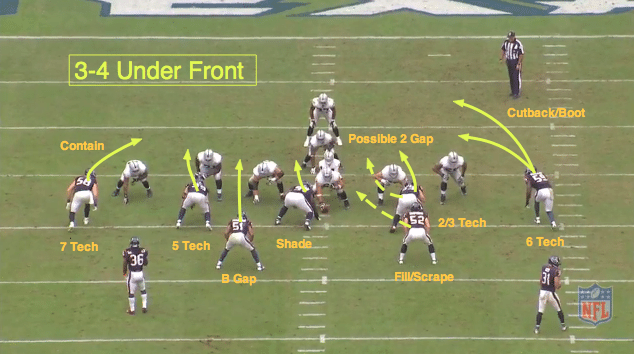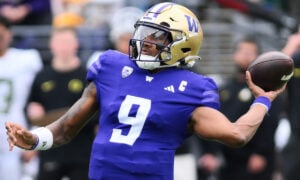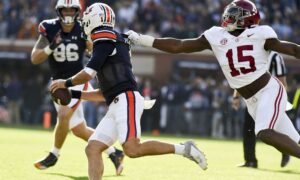IDP Scheme Changes for 2017: Los Angeles Rams
IDP position designation can make or break a player’s fantasy value.
I remember an easier time, a simpler time, when Julius Peppers was lighting up the NFL as a top-tier pass-rusher from the defensive end position with both the Carolina Panthers and Chicago Bears — both teams that run 4-3 fronts. Then, as most IDP players know, the Green Bay Packers and their zone blitz 3-4 got a hold of him, moved him to outside linebacker, and cratered his fantasy value.
However, it was the great fantasy football analyst, Isaac Newton, that theorized, “For every action, there is an equal and opposite reaction.” He meant, of course, that IDP scheme changes also help other players earn more fantasy value.
The Scheme
[am4show have=’g1;’ guest_error=’sub_message’ user_error=’sub_message’ ]
That knowledge is what we are consoling ourselves with after noted defensive coordinator/3-4 defense aficionado Wade Phillips was hired to help stabilize a slumping Los Angeles Rams defense from 2017 onward. This means big changes will be on the horizon for the Rams’ historical 4-3 defense, going all the way back to Merlin Olsen and the “Fearsome Foursome”. Our own Tom Kislingbury noted in his write-up of the Los Angeles Chargers’ scheme shift from a 3-4 to a 4-3 that “Chargers linebackers as a group logged over 1,000 more snaps than their Jaguars counterparts [in 2016]. Meanwhile the Jags’ defensive tackles logged over 1,300 more than their Chargers equivalents.”
Fortunately for IDP owners, it could be worse, Phillips runs what is known as a one-gapping 3-4 defense. Unlike the two-gap scheme that Houston Texans defensive coordinator Romeo Crennel now runs, which asks defenders to “read and react” while not attacking, Phillips’ defense asks its players to be accountable for just one gap in the offensive line, which allows them to get into the backfield and make big plays.
Consider the image below, which shows how Phillips utilized his defense as the coordinator in Houston.

Each member of the front-seven has one line going forward — one gap responsibility that they get to attack and focus on. This leads to more solo tackles, more stuffs, and more sacks than a two-gapping scheme, which waits in front of the line of scrimmage. In fact, Phillips’s 3-4 one-gap defense looks a lot more like the Seattle Seahawks’ productive 4-3 under defense than a classic 3-4. It has the same responsibilities for its players, and it uses similar attacking principles; in the words of Wade himself: “Guys who can rush are going to rush.”
That’s good news for fantasy owners, as — on the whole — defensive linemen in 4-3 schemes are vastly more productive than 3-4. Since 2011, just 36 percent of the top-50 defensive tackle seasons are players who were in the 3-4 scheme, and 18 percent of the top-50 defensive end fantasy seasons were as a result of a 3-4. The top-100 linebackers are pretty evenly split between the schemes, 43 percent coming from the 3-4. Part of this — again, as Tom noted — is due to defensive tackles playing fewer snaps than other positions, and linebackers earning more snaps overall in a 3-4, but it’s worth noting and being wary.
So, with that in mind, what will a re-imagined Los Angeles Rams defense look like in the 3-4?
Nose Tackle
Michael Brockers played just 418 snaps in the Rams’ defensive line rotation last year, partly due to missing two games. Even when he was in, he didn’t do a lot, earning just 19 combined tackles and 1.5 stuffs. 2016 was clearly mostly a down year for the 6’5”, 322-pound behemoth, but we shouldn’t expect a bounceback from him in 2017. Brockers projects to be the starting nose tackle (0-tech) for the Rams next year, a role that Sylvester Williams occupied for the last two years for the Denver Broncos under Wade Phillips; he averaged 27 combined tackles, 2.0 sacks, and 3.5 stuffs over the last two seasons.
If Cam Thomas is retained in free agency this offseason, he’ll be Brockers’ primary backup. The only problem is that there are so few snaps as-is for interior defensive linemen in a 3-4, that the backups get little run at all. This spot saw just 16 snaps in Phillips’s defense in 2016.
Defensive End
This will be the position shift outcry of the century if/when it happens. Aaron Donald is a world-beating defensive tackle in a 4-3 (3-technique). While this year was a down one for Donald, he scored just 0.78 points per game less than Travis Kelce in half-PPR. Averaging 54 combined tackles, 18.8 stuffs, and 9.0 sacks per season, Donald should still hold plenty of IDP value, but loses the positional advantage he once held over other defensive tackles; he racked up 2.50 fantasy points per game more in balanced scoring than the DT2 in 2016. Still, points are points, and his talent is good enough to succeed even if he’s playing in a different-looking front.
Dominique Easley looks like he could play the part of Donald’s bookend. While Donald wouldn’t have to move at all to play the 3-tech (outside the guard’s shoulder), Easley would have to learn quite a bit in order to play the 5-tech (outside the tackle) role for this defensive front. Fortunately, his strengths fit into this defense, as his speed, explosion, and motor allow him to be a good attacking defender, but his shorter arms won’t limit him in getting off of blocks. Easley could see the biggest value jump if he’s reclassified as a defensive end in this front. He already had 35 combined tackle, 3.5 sacks, and 7.0 stuffs for the Rams in limited snaps last year.
Another candidate for this spot is William Hayes. Hayes will be in his age-32 season next year, but has been insanely consistent, delivering an average 46 combined tackles, 4.8 sacks, and 11.0 stuffs over the past three years in limited snaps. He could bulk up slightly without losing some of the explosion that lends itself to power, and is actually a close physical comp to Denver defensive end Jared Crick.
4-3 defensive ends Ethan Westbrooks and Matt Longacre are tweeners for this scheme, so it remains to be seen if they’ll be asked to bulk up to play on the defensive line, or slim down to play outside linebacker. 4-3 defensive tackle Louis Trinca-Pasat should be a depth option here for the Rams.
Outside Linebacker
Robert Quinn undoubtedly will be moved to fill the Von Miller role — strong-side outside linebacker in the Phillips 3-4 defense. Quinn is by far the best pass-rusher on this team when healthy, as he’s proven with three back-to-back double-digit sack campaigns from 2012 to 2014. The last two years saw him struggle with injuries, however, and he has accrued just 9.0 sacks and 7.0 stuffs across 17 games since the beginning of 2015. Quinn’s average 44 combined tackles, 13.3 sacks, and 15.7 stuffs over his peak years would make him a high-end (if inconsistent week-to-week) LB2 in balanced scoring formats, instead of a top-tier DE1. It’s worth looking into selling him this offseason.
The most likely bookend at weak-side OLB is Eugene Sims, who is going on 31 and has had some rocky years with rotational snaps. Sims has started 17 games over the past two seasons, earning an average of 24 combined tackles, 2.0 sacks, and 4.0 stuffs in that span. He’s not going to be a big-time fantasy asset at all, as we would still expect the Rams to rotate these outside linebacker spots.
2016 sixth-round rookie Josh Forrest could see some snaps as an outside linebacker or inside in this scheme. Forrest was a movable chess piece in college at Kentucky, and with his long limbs (33.5” arms) and decent change-of-direction agility (4.22 short shuttle), he could allow Quinn a breather at the strong-side spot. In 90 snaps as a rookie, Forrest earned seven combined tackles, 2.0 stuffs, and one quarterback hit.
Undrafted 2016 rookie Morgan Fox should also make the move to outside linebacker. While he played just four games in 2016 (75 snaps), he earned five combined tackles, 1.5 stuffs, and 2.0 quarterback hits. Fellow 2016 UDFA Cory Littleton could be moved outside as well, having been credited with 35 quarterback pressures and 6.0 sacks in his final year of college. As of now, neither are rosterable.
Inside Linebacker
Alec Ogletree has been dominant at whichever linebacker spot he lines up, having played 4-3 WILL for a few years before making the move to MIKE last season. This actually boosted his fantasy production quite a bit, as he racked up 172.5 fantasy points as LB5 in balanced scoring in 2016; he was LB18 in 2014, with 146.0 points. He’s averaged over 120 combined tackles in his healthy seasons, to go along with 8.2 stuffs, 10.7 passes defensed, and 1.7 interceptions. A shift to the inside is not scary for him; due to Ogletree’s attacking ability inside, something like Brandon Marshall’s 2015 campaign with 101 combined tackles, 4.0 stuffs, and 4 passes defensed might be his floor in a Phillips 3-4. He’s still a premium IDP asset.
Mark Barron becomes an interesting question mark with this move inside. His 2017 season could look like similarly fast and coverage-able inside linebacker Danny Trevathan’s 2015, with 110 combined tackles and 6 passes defended. His 3-4 weak-side ILB role shouldn’t be much of a change in responsibility from his 4-3 WILL role up until now. Last year, he had 117 combined tackles, 7.0 stuffs, and 8 passes defensed. He’s a shoo-in for triple-digit tackles and some combination of bonus points somewhere, leading to likely another solid LB2 season.
Bryce Hager is the most apparent depth here, as he’s at his best as an inside linebacker. The only problem is that reduced bodies upfront means he will have to engage blocks more in the trenches, and that is not a strength of his. Hager doesn’t have the upper-body power or arm length to beat interior linemen, so he’ll likely be little used by the Rams.
Defensive Backs
There won’t likely be any position changes in the secondary, but it’s important to note that a slight majority of the top-50 defensive back seasons since 2011 have come from the 3-4 (56 percent), and almost all of them were safeties.
Denver’s strong safety would have been the fourth-most high-scoring safety in balanced scoring in 2016 and the 13th-most in 2015 in a full season of snaps. This bodes well for the Rams’ T.J. McDonald, who remains a strong DB1. For two years in a row, as well, the Denver free safety ranked around the 30th-best safety, so we can safely continue to ignore Mo Alexander in all but the deepest formats.
Phillips like to play press-man with his cornerbacks when he can, so we could see E.J. Gaines, Trumaine Johnson, and Lamarcus Joyner continue to lose value as they get used in shadow coverage and as blankets instead of playing softer zones that allow more catches — and therefore more tackles. Of the Denver corners this year, only Chris Harris, Jr. was inside the top-40 of cornerbacks in balanced scoring leagues.
[/am4show]
- The IDP Impact of Steve Wilks to the Cleveland Browns - March 2, 2019
- The IDP Impact of Gregg Williams to the New York Jets - February 8, 2019
- The IDP Impact of Vic Fangio to the Denver Broncos - January 29, 2019

































































